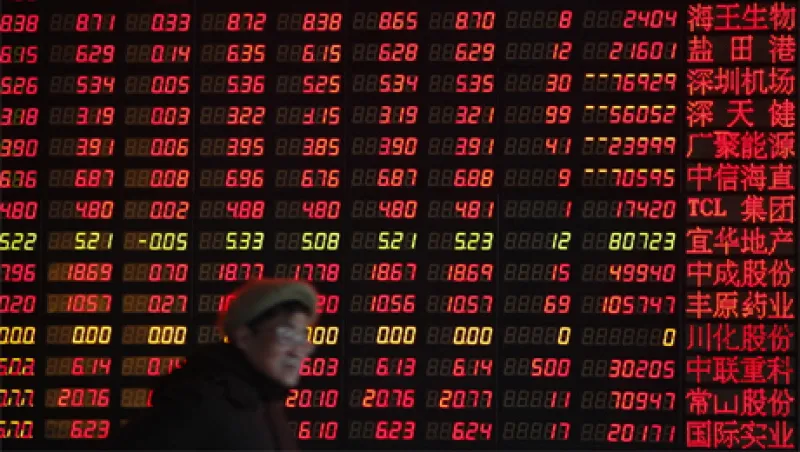China is making it easier for more foreign institutions to buy domestic securities in a fresh attempt to deepen institutional presence in the country’s lackluster stock markets. How overseas investors respond remains to be seen.
Chinese regulators earlier this year announced rule changes to the Qualified Foreign Institutional Investor (QFII) program, the primary vehicle for international investors to directly buy and sell locally listed securities.
Under the amended rules, the threshold for overseas fund managers, insurers, pension funds and other institutional investors to participate in the QFII program was lowered to $500 million from $5 billion in managed assets. At the same time, total quota for the QFII program was expanded to $80 billion from $30 billion.
“Market entry is becoming easier,” said Howhow Zhang, research director at Z-Ben Advisors, the Shanghai-based investment management consultancy, in an interview with Institutional Investor. The new rules also raised the maximum stake a QFII can own in a Chinese-listed company from 20 to 30 percent.
“Chinese regulators want to introduce more institutional investors into the domestic stock market to help internationalize its investor base and promote value investing. Chinese regulators also expect the introduction of foreign capital will boost the domestic markets,” Zhang said.
The QFII program, which was initiated in 2002, stalled six years later with the onset of the global financial crisis, as regulators clamped down on cross-border capital flows. That is changing under the direction of Guo Shuqing, the former chairman of China Construction Bank who last October became head of the China Securities Regulatory Commission (CSRC), the country’s stock market regulator.
Since the start of the year, China has approved 52 QFII licenses and $9.18 billion in quotas, according to a report published Monday by the China Securities Journal. That compares with 29 license approvals and quota allocations of $1.92 billion for all of 2011. Foreign institutional investors still must obtain a QFII license from the CSRC, followed by a separate investment quota from the State Administration of Foreign Exchange.
Total overseas investment through the QFII program now stands at about $31 billion. That represents less than 1 percent of the capitalization of China’s "A-share" equities market. By comparison, foreign participation in South Korea’s domestic market in September amounted to 31.8 percent of total capitalization, or $366 billion, while overseas investors owned more than a quarter of Japan’s stock market–listed securities last year.
New QFII license holders include the Qatar Investment Authority, the Board of Regents of the University of Texas System, the Ontario Pension Board and the Church Pension Fund. In August Principal Global Investors, the asset management arm of Principal Financial Group, announced it had secured a $150 million quota.
“We’re looking to launch a pure China A-share equity fund that mostly targets existing clients and potential prospects,” said Tony Chu, a Singapore-based portfolio manager with Principal Global Investors, which as of June 30 held assets of $259.8 billion, primarily for retirement plans and other institutional clients.
QFII managers don’t expect an immediate rush into Chinese stocks, however, as the country’s slowing economy and declining corporate profits continue to drag down domestic markets. The benchmark Shanghai Composite index has lost more than 7 percent over the last 12 months and has shed about two thirds of its value from its 2007 highs.
Corporate profitability is expected to continue to decline, mainly due to overcapacity in key sectors and overleveraging by some companies as a result of China’s stimulus program launched in 2008, said Minggao Shen, a Hong Kong–based equity strategist at Citigroup.
“The profit-margin squeeze is clear, but the remedy is not,” said Shen. “That’s why we are stuck in the middle of the tunnel and we can’t see any light.”
Overseas institutional customers also are waiting on the sidelines until China completes its senior leadership transition, which is expected to commence at the 18th National Congress of the Communist Party of China, which convenes November 8 in Beijing.
“The sentiment has been mixed,” said Chu of Principal Global Investors, who is now discussing his A-share equities fund with sovereign wealth funds, corporate pension plans and corporate institution clients.
Dustin Kuo, Managing Director Global Market Equities for Deutsche Bank Asia, maintains that the rules changes represent a crucial watershed for China’s market opening. ``This is important, considering the size of the market and how internationalized some Chinese companies have become,” Kuo said. “A diversified investor base is important to China's increasingly global companies; it's not optimal for them to have only domestic investors.”
Zhang of Z-Ben Advisors anticipates further regulatory amendments in the coming months, including rules allowing QFIIs to raise their exposure to nonequity investments, including bonds, to 50 percent of their total Chinese holdings. Top-tier QFIIs also are expected to be allowed to expand their quota above the present limit of $1 billion. China’s new QFII quota of $50 billion may be allocated as early as 2015, Zhang said.
Despite current market difficulties, allocation requirements, over time, will encourage global fund managers to continue to invest through the program, explained Principal’s Chu. The Chinese economy currently represents about 12 percent of global economy, while China’s domestic market capitalization surpassed Japan’s in 2011. Meanwhile, China’s A-shares remain absent from global emerging-markets indexes. “As more quota becomes available, that will change,” Chu said.






